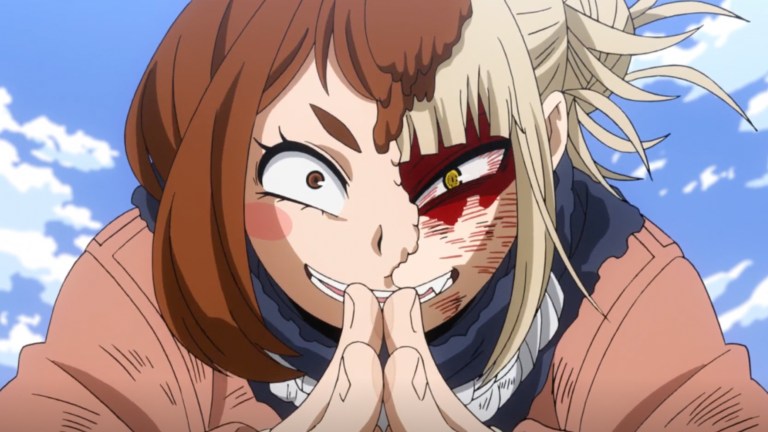My Hero Academia Season 5 Episode 21 Review: Revival Party
The “My Villain Academia” arc continues with a fascinating look into the origins of evil and why the Meta Liberation Army are so dangerous in My Hero Academia.

This My Hero Academia review contains spoilers.
“What is…a normal life?”
“Normalcy” is often viewed like it’s some congenital defect in My Hero Academia and there are plenty of characters in the series who view a lack of special abilities as a confirmation of inferiority. Granted, My Hero Academia exists within such an exaggerated world that there’s a sliding scale of what qualifies as “normal,” especially when it comes to the context of society’s villains. Contrasting opinions are presented on which villains are acting “properly” and have the best vision for not only the state of villainy, but society itself.
In this case, this translates into a deadly battle royale where might makes right and the ideology of the strongest villains will dominate. It’s a very solid foundation on which to build an episode, but “Revival Party” becomes an even more exceptional installment of My Hero Academia for how it effortlessly mixes its high-minded ideas with non-stop action, intimidating Quirks, and provoking character development. Who would have thought that a group of misfits led by an edgelord with stringy hair and dry skin would have such depth?
“Revival Party” engages in a fascinating look back to the chaotic days of when Quirks first revealed themselves as well as the public’s response to these massive changes. Among the many opinions on what to do with these powerful individuals, the discourse towards liberation–rather than suppression–was one valid perspective that ultimately went overlooked. It makes sense that a good deal of the public would believe that this introduction to Quirks is completely natural, so the same rules should also apply to their use. There’s obviously a lot to police when it comes to these powers, but it’s believable that others would want these changes to just naturally evolve.
Destro is an individual that My Hero Academia has allowed to lurk in the shadows through flashbacks and cryptic threats, but “Revival Party” provides a substantial look into the radical figure. Destro’s unwavering convictions were funneled into his incendiary manifesto, the Meta Liberation Army, which continues to inspire Quirk users in dangerous ways even long after the loss of Destro. However, unbeknownst to Destro is the news that he had a child–Re-Destro–who is more than willing to take up the mantle of his father as he challenges Tomura Shigaraki and the League of Villains’ way of life.
Up until this point the threat that the Meta Liberation Army poses has been more nebulous and mustache twirling in nature, but Re-Destro’s threats to Giran finally show their hand a little. “Revival Party” addresses that the major obstacle that the League of Villains face is that their Nomu supply has run out, which basically reduces them to a bunch of angsty cosplayers. This is a fair advantage for Re-Destro to try to take advantage of, but it also reflects just how little he knows about the League of Villains. Granted, the Nomu have become their primary means of force, but there are still tremendously valuable Quirks within the League. Shigaraki’s Decay remains one of the most destructive powers in the series, but it’s not as if his support is stuck with Quirks like Earphone Jack or Tail (apologies to Kyoka Jiro and Mashirao Ojiro).
The ultimate trial by fire begins when the collective forces of the Meta Liberation Army, whose numbers exceed 110,000 faithful followers, launch a surprise ambush on the League of Villains. It’s exciting to see this well thought out plan go into action and it immediately gives this meeting a different flavor than all of the previous showdowns between heroes and villains. Such chaos ensues that it honestly wouldn’t have been an issue if an entire episode was devoted solely to this battle and its barrage of unexpected Quirks. It’d even act as a suitable counterpoint to how so much of the beginning of this season focused on a showcase of what U.A. High’s Class 1-A and 1-B can accomplish.
There have been some dangerous encounters featured in My Hero Academia, but the moments where the League of Villains precariously venture into Deika City honestly feel akin to when Martin Sheen’s Captain Willard and his forces first boat through Vietnam’s Nùng River to parlay with Colonel Kurtz in Apocalypse, Now. This is unfamiliar territory where everything is a potential threat and there is non-stop attention placed upon these intruders. Even though large spans of this “My Villain Academia” arc are set in the past, it’s still one of the more suspenseful sequences that the series has put together.
My Hero Academia’s five seasons have conditioned the audience to believe that the League of Villains will come out on top and overcome these enemies, just like they’ve done with Stains’ forces or Overhaul and the Shie Hassaikai in the past. However, “Revival Party” starts to suggest that maybe the Meta Liberation Army will actually succeed, or at the least, seriously change the makeup of what the League of Villains look like. There could be a major shift in the series’ villains as these two opposing forces slowly eliminate each other or progressively coalesce into one dangerous organization. It’s still too soon to tell, but the situation already feels highly uncomfortable. Whoever is left standing will be more motivated to enact righteous change than ever before. It’d be fascinating to look at a new version of the League of Villains where both Shigaraki and Re-Destro share leadership and precariously work together towards a larger mission to reform society.
The larger fight between the League of Villains and the Meta Liberation Army gets broken up among its many players, which results in the always-entertaining Himiko Toga receiving a ton of attention. Toga has been compelling and terrifying ever since her first appearance, but she becomes the obsession of Meta Liberation Army’s Chitose “Curious” Kizuki and the subject of much deeper scrutiny. Curious is a captivating villain who benefits from an explosive Quirk, but most commonly leans on journalism skills to define her character. Curious attempts to relitigate Toga’s past and in many ways it would be appropriate if this episode were called “Himiko Toga: Origins.”
Important context is provided for this wild character, which also speaks to how she’s very much been a victim of circumstance through her life and arguably never stood a chance at normalcy. “Revival Party” is incredibly useful to help understand why Toga is how she is, as well as what exactly she gets out of her involvement with the League of Villains. The visual of a young Toga gleefully sucking and chewing on the head of a dead baby bird is also easily one of the more disturbing visuals that My Hero Academia has ever produced. The hybrid of Toga and Uraraka that she temporarily takes on during the height of battle is also another evocative image from this powerful episode.
Toga and Curious engage in one of the episode’s best battles and Curious comes across as unhinged as Toga, which is seriously difficult to do. There’s a raw, visceral nature to ever attack that lands between these two. Curious’ efforts to cripple Toga’s power reserves by turning blood into bombs is also a brilliantly evil strategy. “Revival Party” spends a lot of time on Curious, but it feels justified and that a serious defection from Toga could be on the way. Toga’s role as a “villain” is put under scrutiny, which in turn triggers serious reflection through her ride-or-die ally, Twice. On that note, as crucial as Toga is to the Meta Liberation Army’s plan, it appears that Twice serves an even greater purpose since his Quirk can be re-appropriated to make more copies of Re-Destro and basically guarantee that he never completely perishes since there are “back-ups” available.
“Revival Party” never stops moving and all of this mayhem is just so much fun. The series feels energized by this shift in perspective and such heights are reached that turning “My Villain Academia” into its own spin-off wouldn’t be the worst idea (or imagine the potential in a new My Hero Academia feature film coming out, but that it’s entirely focused on the League of Villains). My Hero Academia would seriously suffer if it completely removed its villains from the equation, but it’s clear that these complex characters have reached a point where they demand more screen time and that the typical glimpses that the anime provides are no longer enough. Audiences are at the point where they want to see “Twice: Origins” or Gecko’s entrance exercise to gain admission into the League of Villains.
My Hero Academia continues to triumph with its dedicated focus on its villains and “Revival Party” is just a riot in terms of plotting and visuals. It remains a risk for the series to spend so much time out of its comfort zone, yet entries like this are proof that it’s the whole universe of My Hero Academia that’s intriguing. Whether the series follows heroes, villains, or something in between, it still delivers action-packed excellence.
